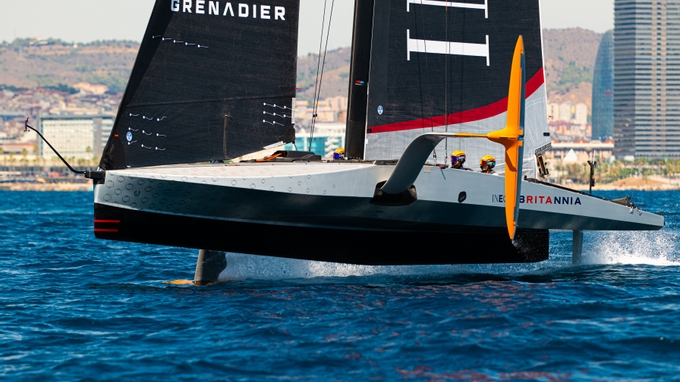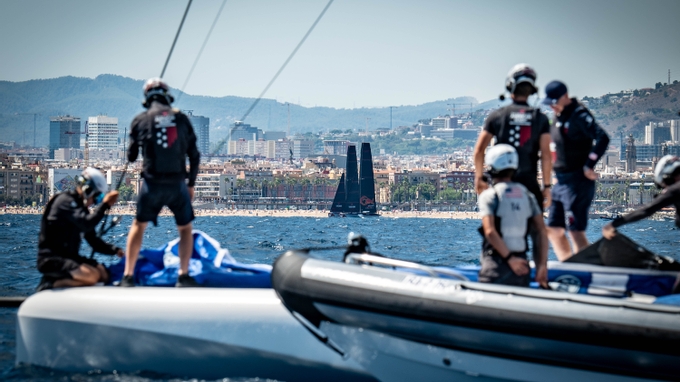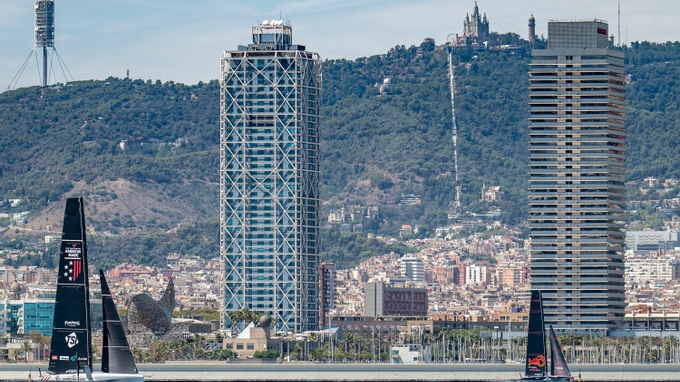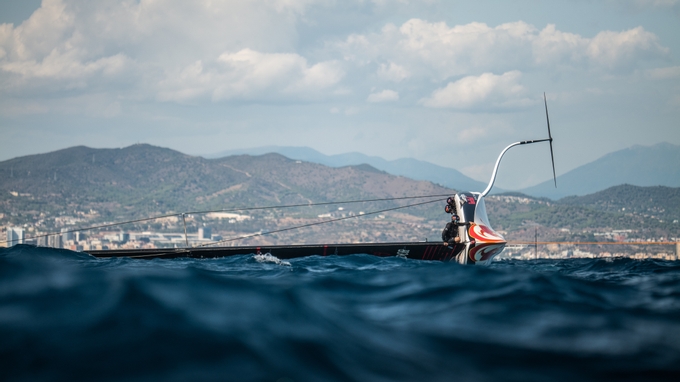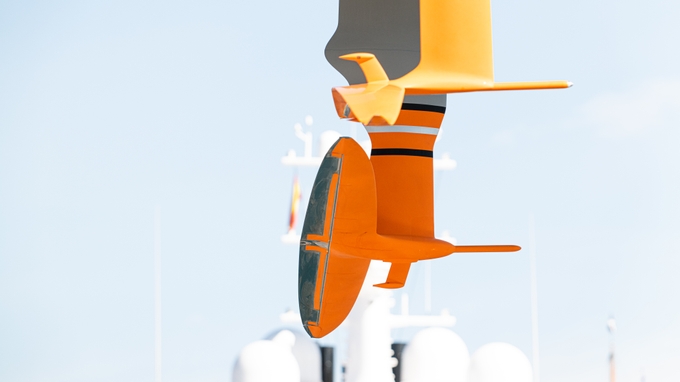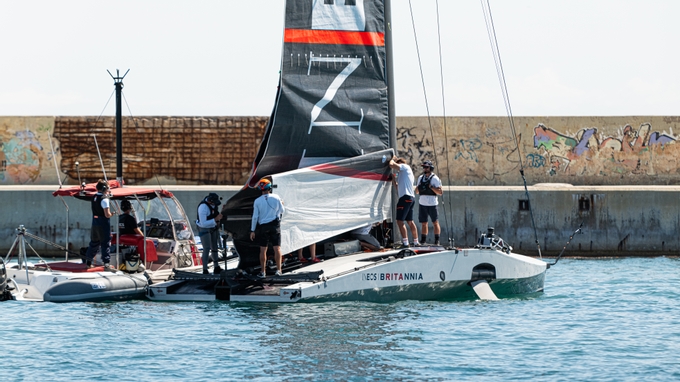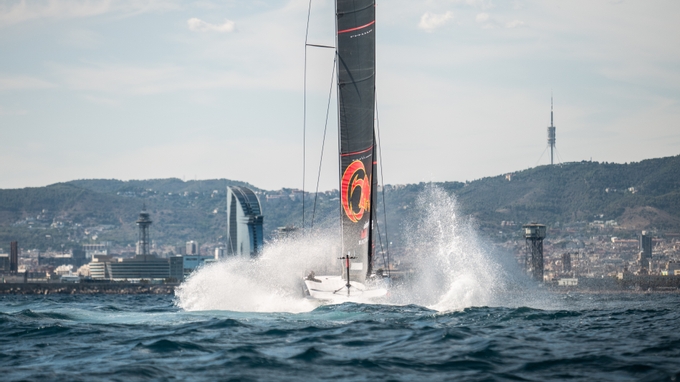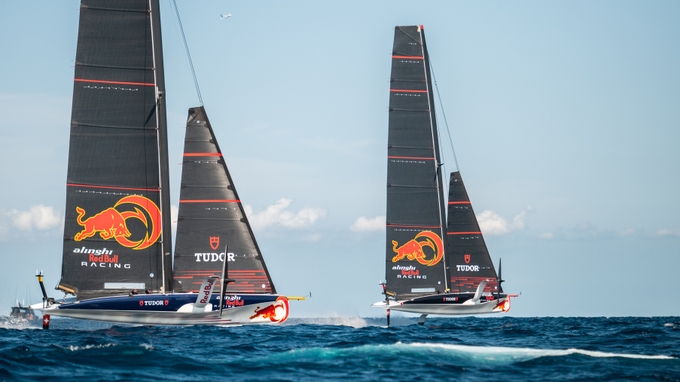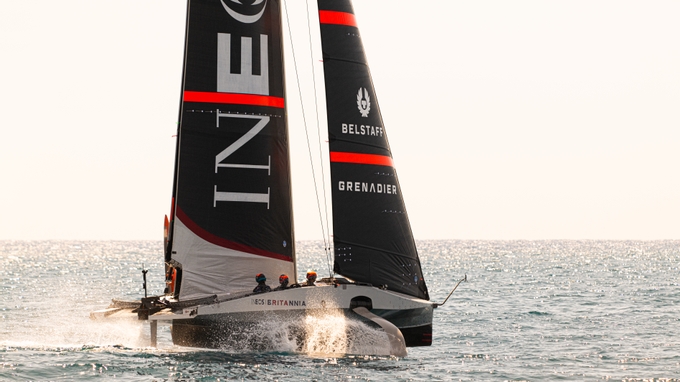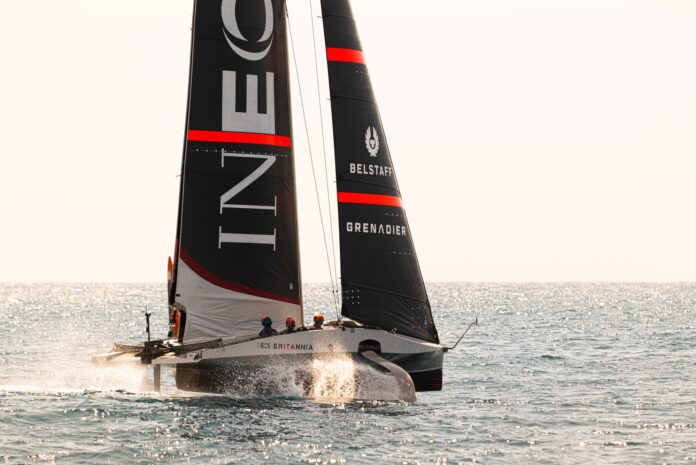INEOS Britannia pushed hard on Tuesday with a two-boat programme, launching both their LEQ12 prototype ‘T6’ followed by their AC40 ‘Athena’ as preparations for the first Preliminary Regatta in Vilanova i La Geltrú ramp up. Ben Cornish and Dylan Fletcher-Scott put T6 through its paces after a frustrating day on Monday where boat failure precluded any meaningful testing, and the duo were keen to find the edges of performance with some wild cavitations and ventilations. Testing is not about looking good, it’s about providing data and with T6 wired up in real-time back to the Mercedes Applied Science team in Brackley, Northamptonshire, the sailors delivered on all accounts.
The British team split their afternoon in two with T6 data gathering whilst the AC40, with Ben Ainslie and Giles Scott onboard, concentrated on regatta preparation. Something that we haven’t seen much of in this America’s Cup cycle is variance in rudder design. INEOS Britannia have played with rake but the design of the rudder on T6 has been a constant throughout the campaign to date. That’s due to change though with the recon team spotting three new blades in the yard that will presumably be given to the test team in the coming days to try out.
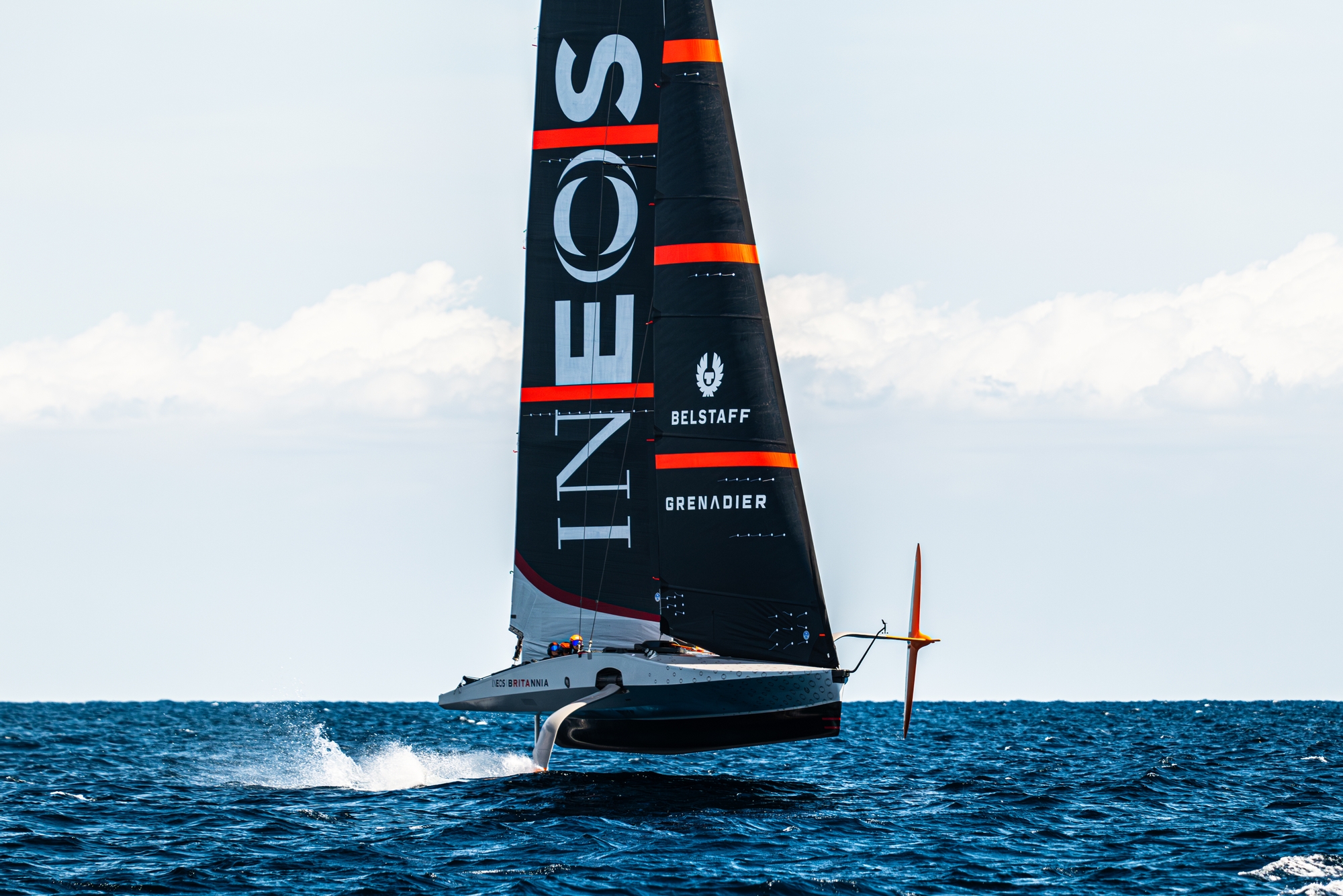
On the water, the test team looked sharp with Iain Jensen and Luke Parkinson flying uncomfortable test modes to stall out the foils and push them to the edges. Ugly splash-downs and falls off the foils ensued over a three-hour session that Dylan Fletcher-Scott later described saying: “You’re always try to balance between clearing the bustle and then you’ve got the foil and how much tip out and so we’re experimenting with different options and sometimes we get it a little bit wrong and you either ventilate the whole foil or the bustle touches too much and that’s when you see those moments.”
INEOS Britannia have persisted with their standard asymmetric foil set-up since ditching the W-foil and when asked about the variance, Dylan offered: “They’re quite different. As you can see there’s big differences between how they look, and both have got their pros and cons but ultimately, they’re just providing data for Brackley and they’re able to hopefully design a very fast race yacht for us.”
Valuable day for the British in perfect 8-14 knots of breeze and relatively flat water for Barcelona.
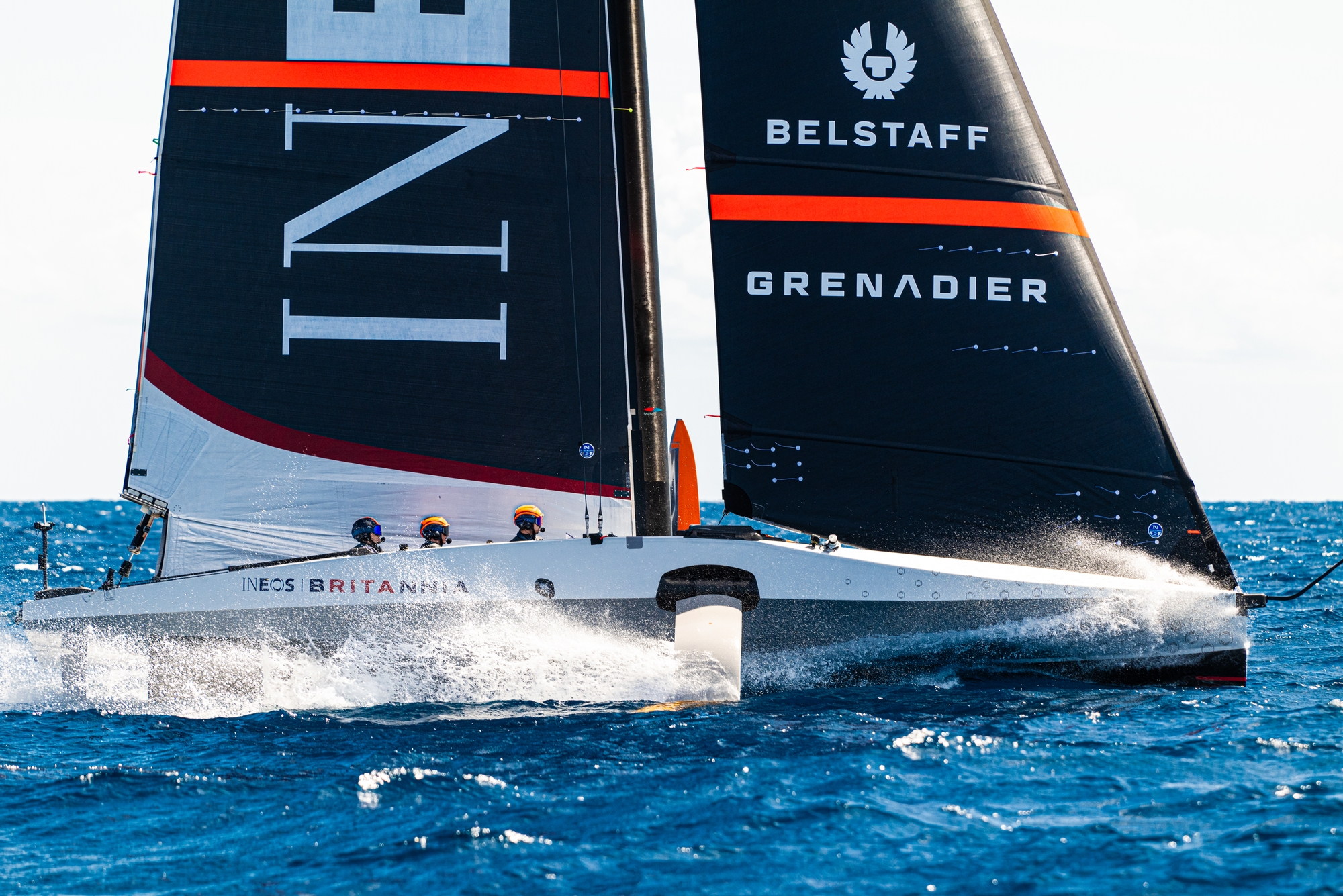
Also taking advantage of the weather window post the weekend storms that blew through the Mediterranean and brought a sweltering summer to somewhat of a change, was Alinghi Red Bull Racing and NYYC American Magic but with rather different training strategies. The American team declared a fifth upgrade to ‘America’s’ port foil (E) and the team were keen to push in up-range conditions and find the limits. Those limits were truly found in the line-ups with cavitations and nose-dives aplenty on a three-and-a-half hour sailing session shere the wind filled faster than the team was expecting as coach Tom Burnham described, saying: “Yeah in fact it was perfect, it was exactly what we intended to do today. We knew that we were coming out after a big light air section in the middle of the day today and that we would have a build and we were hoping for it to get windy at the end of the day. We needed to do some to some foil testing in the heavier and windier conditions, but we knew we were going out earlier than the build happens, so we planned to do a little bit of racing while we were waiting for the wind to fill in and the wind filled in quicker than we expected so it was perfect, we did one race and then straight into some testing so it’s a good afternoon.”

The Americans are eyeing a decent result in the upcoming Preliminary Regatta and for the first time from any team, Tom acknowledged the pressure that’s building saying: “There’s lots of pressure. Of course, everybody wants to do well and Villanova it’s a big important event for the team and for all of our supporters. We’re thinking about it and looking forward to going to down to Vilanova and go racing so for sure we’re thinking a lot about it but at the same time we’re we know the bigger picture and keep working towards helping design the boat for the new AC75 so it’s a bit of a balance to try and figure out how much race training we do and how much design work and testing we’re doing, so it’s just working back and forth depending on the sea state and the conditions that we have on a given day.”
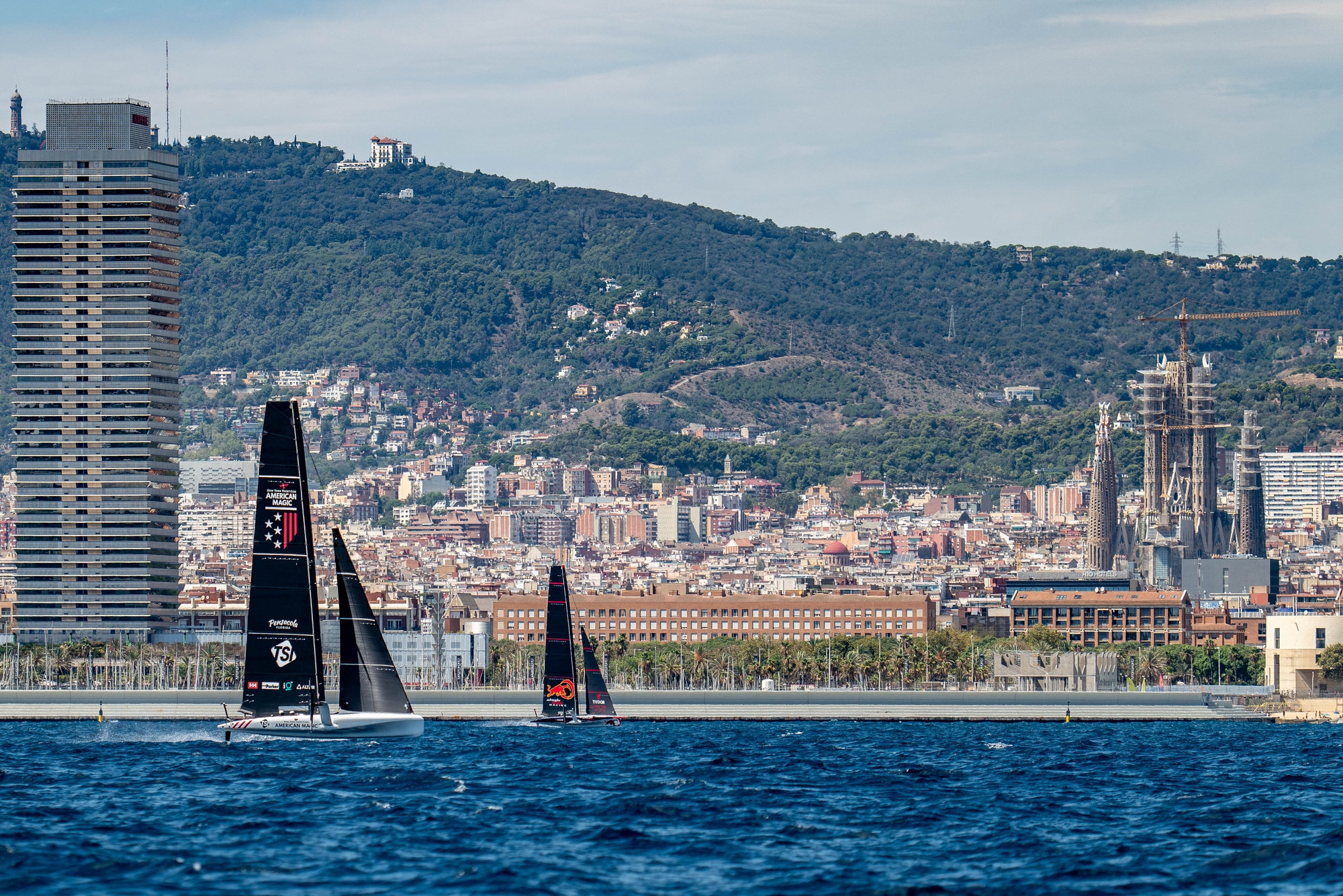
Alinghi Red Bull Racing continued their build-up to Vilanova with another sensational two-boat testing day with both of their AC40’s in one design mode and set up. The line-ups were fast, furious and desperately close with Phil Robertson pairing again with Dean Barker to push Arnaud Psarofaghis and Maxime Bachelin to their race limits.
With so much pressure and intensity on the racing, it was no surprise to see a capsize and several large cavitations and falls off the foils with both teams really pushing to see where the gains could be made. On balance, Arnaud and Maxime had the better of the three-hour session, showing marked improvement on the previous day and looking promising going into another pre-event practice race session that starts on Thursday. Alinghi Red Bull Racing very much look like they are peaking at exactly the right time and Vilanova will be a fascinating insight into exactly where this dynamic team are right now.
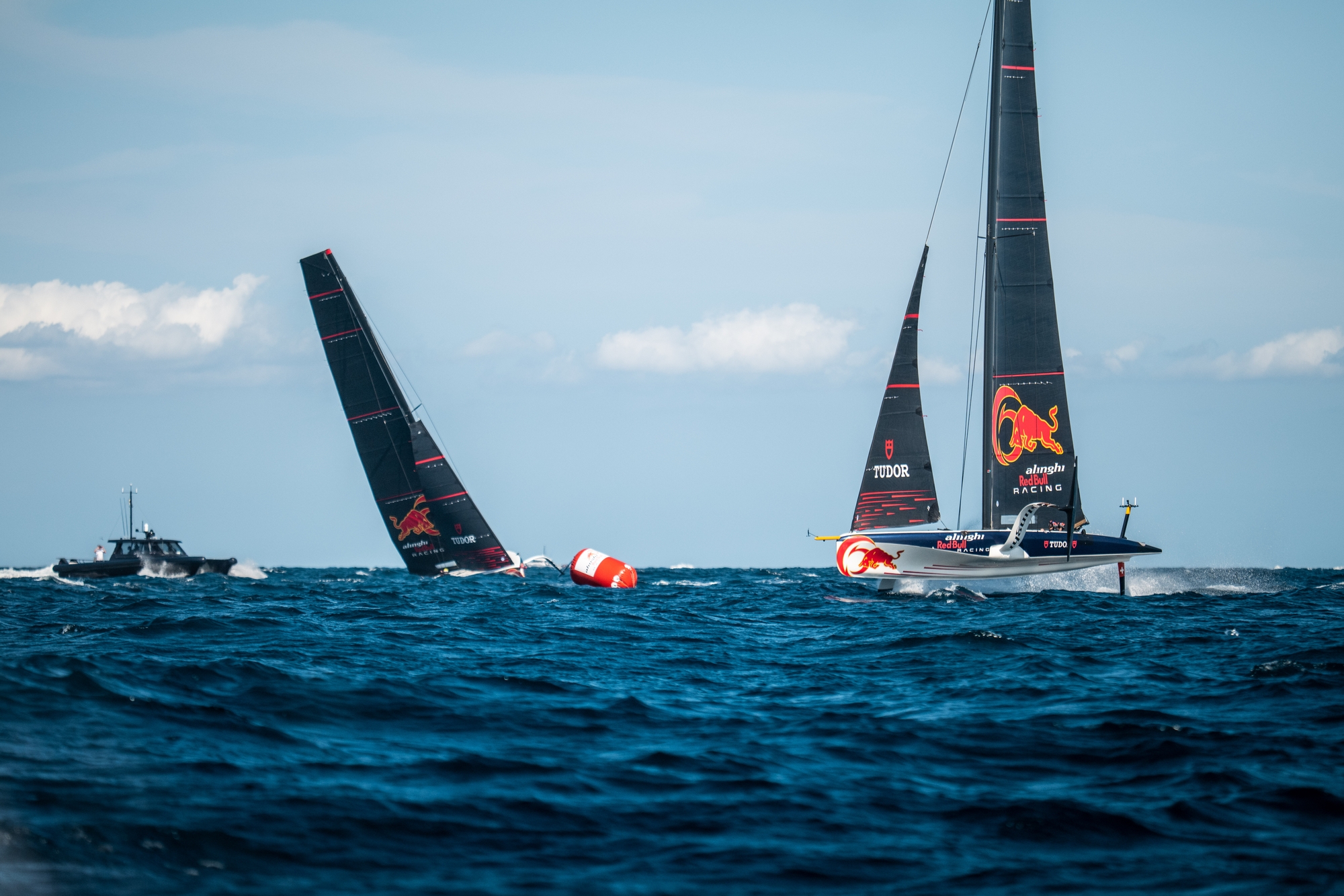
On-Water Recon Report – Alinghi Red Bull Racing: Alinghi Red Bull Racing rolled out their AC40-4 (YELLOW) at 11:45, continuing with one-design foils. The AC40-7 (RED) was rolled out at 12:20, also in one-design mode. Decal stickers from the bottom side of the hull on the red boat were removed before craning in. Standard pre-sailing checks were carried out before dock-out at 14:00. Both boats raised sails in port and began sailing from the port entrance at 14:20.
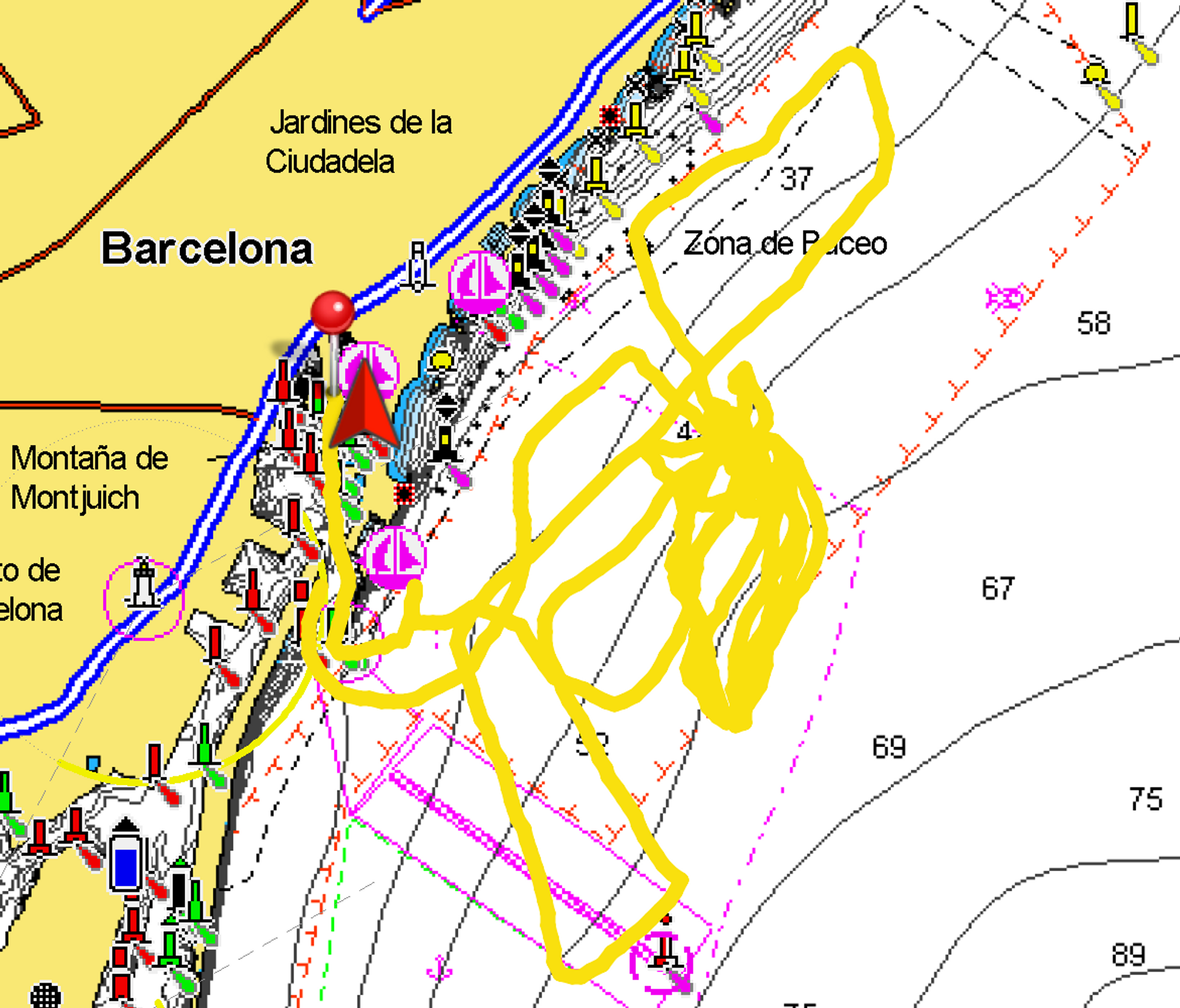
The ‘Garbi’ afternoon thermal wind ranged between 12-15kn from the South. A residual East Swell was still present, with the increasing South wind creating the typical choppy conditions. All sailors started in the same positions as the previous day, with Arnaud Psarofaghis and Maxime Bachelin helming the red boat, Phil Robertson and Dean Barker helming the yellow boat.
In the first stint, both boats sailed upwind and downwind in close proximity, executing synchronized tacks and gybes. The second stint consisted of a pre-start practice, as the yellow boat started the race approximately 15 seconds late, prompting a restart. Both boats sailed with both boards down for the majority of the pre-start as the strength of the gusts increased.
The third stint consisted of a one-lap race as the breeze continued to build . The red boat secured the win. Subsequently, both boats switched from J2 to J3 jibs. In the fourth stint, a two-lap race was held, with both boats fighting for the lead in close proximity. The yellow boat initially defended the first three legs but touched down after the final windward rounding, allowing the red boat to overtake and maintain its lead to the end.
The fifth stint began with the yellow boat touching down after tacking onto the start layline, giving the red boat an advantage at the gun, however the race was restarted. In the following race, the red boat lost control while tacking onto the windward mark layline, enabling the yellow boat to create a significant lead, which it held until the finish. After this race, a full crew swap was done between the boats.
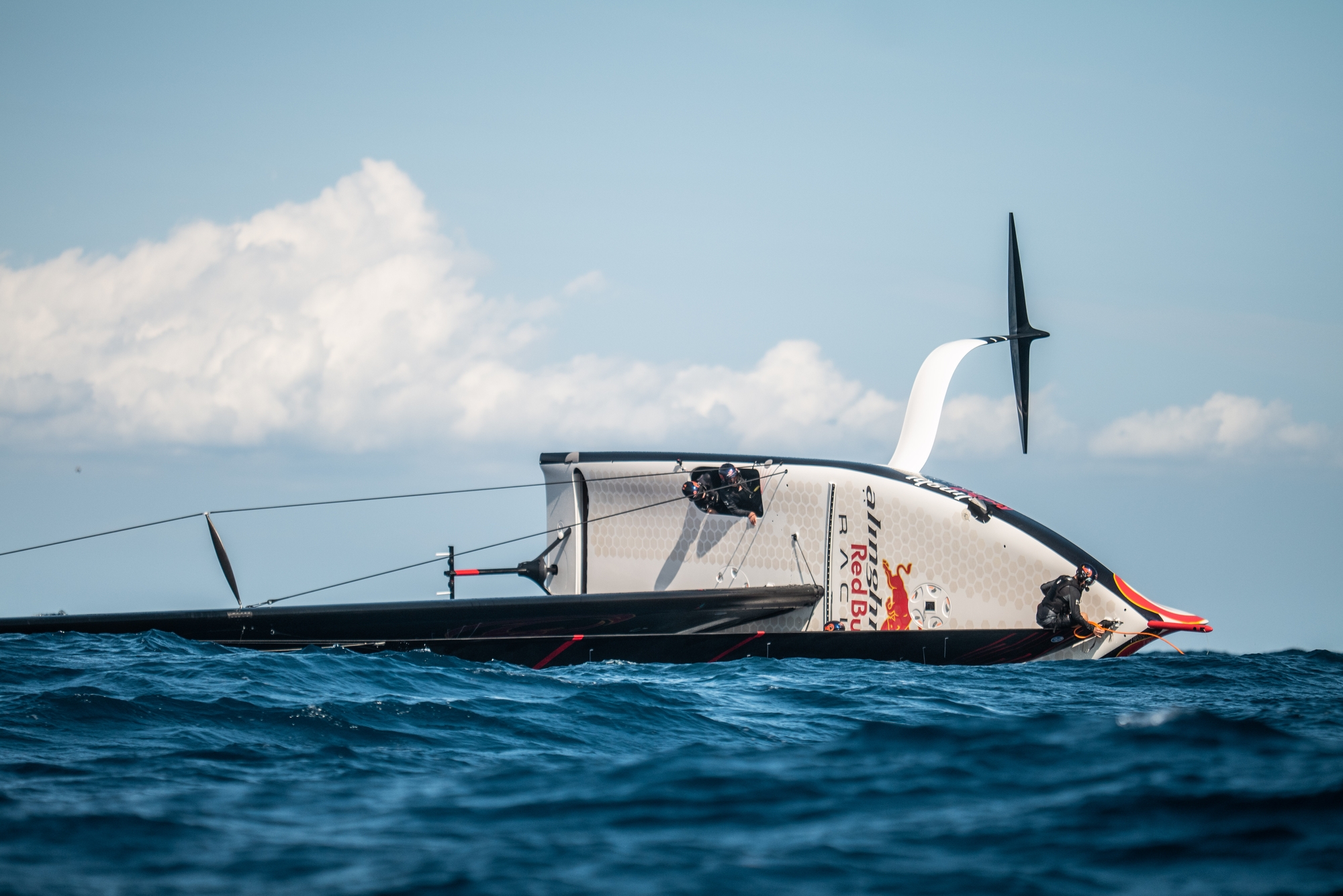
The sixth stint saw the red boat capsizing during a bear away just a few minutes into after swapping seats, right before the pre-start sequence. The red boat was righted within 5 minutes via the chase boat and checks were carried out, as the yellow boat went back on tow. Both boats then sailed upwind towards the base, marked the seventh and final stint of the day. Sails were lowered at 17:00 and both boats were towed back to base, docking in just before 17:30.
34 Nautical Miles were covered by the recon boat, observing the team three-and-a-half-hour session on the water, of which 110 minutes were spent sailing. 58 manoeuvres were counted of the Arnaud P and Max B team, averaging at 97% fully foiling.
On Water Recon Report – NYYC American Magic: American Magic rolled their AC40’s from the shed at 10:05h with a new version of their port wing foil AM-LEQ-FW3 #3 version E as they announced in today’s Component Declaration.

America; black foil with a spat and elevated tips on starboard and the new version on the silver port foil. Magic; stock foil on starboard side and silver bended with elevated white tips on port side.
They proceeded with the mast stepping procedure and by 11:56h both boats where in the water. The team docked out at 12:56h with Paul, Michael, Andrew and Lucas on board America and Tom, Finn, Harry and Riley onboard Magic. As regards intensity, building during the day starting with 8knts 155º, and ending the day with 14knts on average from the South measured at sea level, and a bumpy, confused sea state from the East. Today’s session was planned to test on their foils in windy conditions. They hoisted Main #4 and J1 #2 inside the harbour and by 13:35h they started sailing upwind-downwind doing several manoeuvres (7tacks and 5 gybes).
As the wind increased at 14:16h they hoisted J2 #3 and 6′ later they continued sailing upwind doing line up’s and testing on speed. At 14:28h one lap upwind-downwind race was conducted starting in between two marks also used as gates. Here we started to see that the boats were becoming harder to control as the foils were struggling to generate lift from the vapourised water surrounding it. Sometimes managing to decrease speed so the foils recreate their traction again and many others ending up nose-diving due to the cavitation and making them stop.
At 14:42h they hoisted J3 and tested upwind on their port foil for 16′. Next, America checked and fixed on their port foil and just before taking off their sheets come off. The testing continued for 10 more minutes and ended with a touch down.
They swapped batteries and sailed for another 40′. At 17:00h they went bearing away back to port where they put the main and the J3 down ending up their training.
On-Water Recon Report – INEOS Britannia: INEOS Britannia launched both their T6 LEQ122 test boat and their one-design AC40 today, but the two yachts sailed separately with the AC40 launching at 1015 and TT6 at 1055. T6 docked out first at 1230 and with the M2-2 mainsail and J2-2 up was out of the harbour by 1305 and quickly on to its foils in around 8 knots of breeze and on a flat sea. Other than a brief stop after a big splash down on port upwind the boat stayed airborne until 1411 when the crew stopped, following a long straight downwind run from a point where we were close to being out of sight of land.

Minutes later, T6 was up and running again for another windward leeward lap that ended at 1455 close to the entrance to the harbour. With the British AC40 rigging up just inside the breakwater (Ben Ainslie and Giles Scott with Bleddyn Mon and Leigh McMillan) the T6 crew (Ben Cornish and Dylan Fletcher with Luke Parkinson and Iain Jensen plus Neil Hunter as 5th) man called time on their session at 1500 with sails down shortly after and dock-in taking place at 1530. There were few manoeuvres from T6 during the session with the focus appearing to be on experimenting with flight heights at a variety of wind angles (including some reaching) as well as sailing bow-up upwind on several occasions.
The manoeuvres that did take place appeared a little ragged from our observation position – especially as the chop and swell built slowly over the session (never over 0.5 metres). That said, T6 showed no signs of the issues encountered during yesterday’s (Monday August 28) session and appeared to be functioning well. Based on data from Marine Traffic the British AC40 docked in around 1740. General observations: Three rudder blades of varying sizes were spotted in the yard close to where the boats are rigged. Several of what looked to be the AC40 racing headsails were hoisted on the dock – presumably to check their fit.
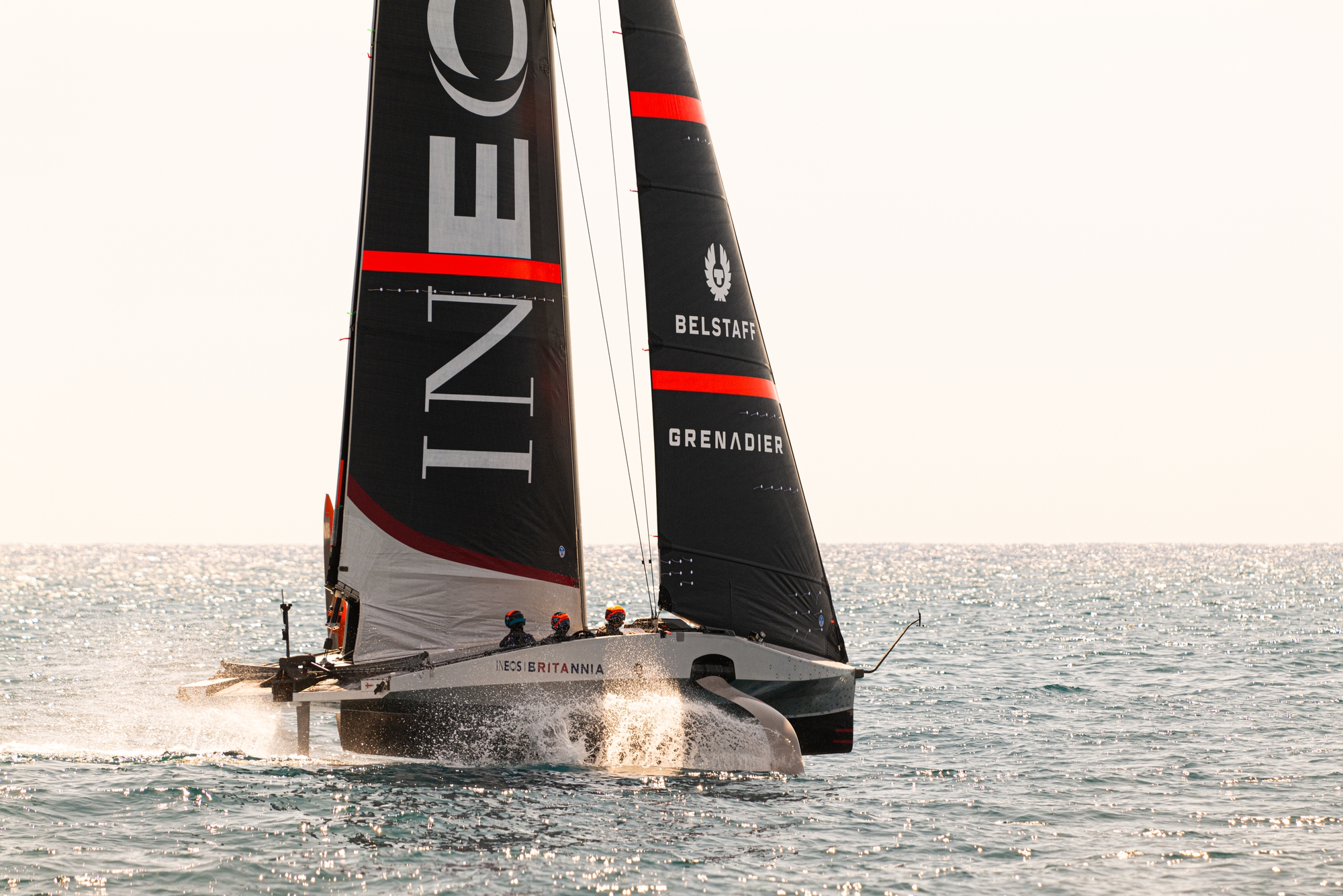
UGO FONOLLÁ / AMERICA’S CUP
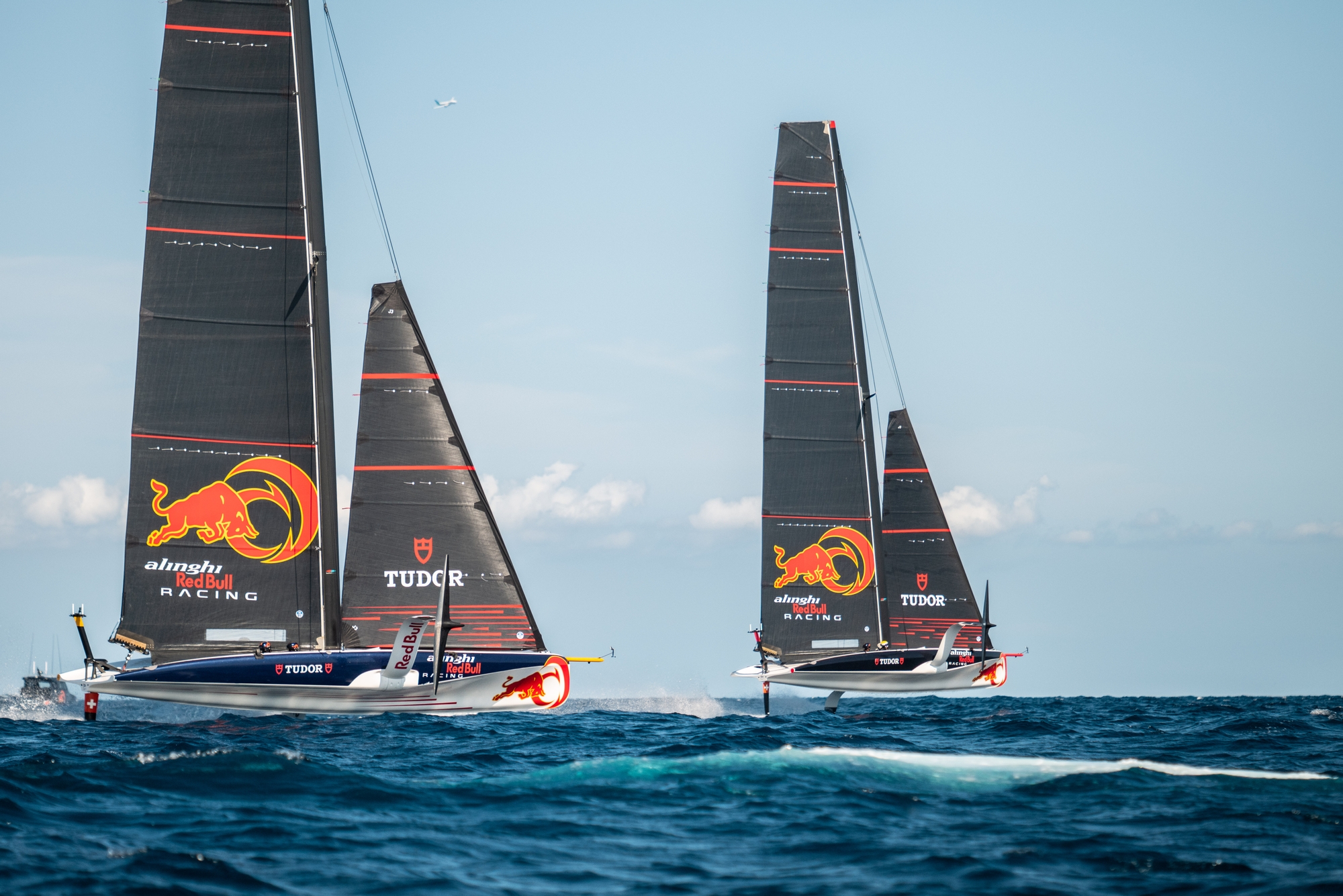
ALEX CARABI / AMERICA’S CUP
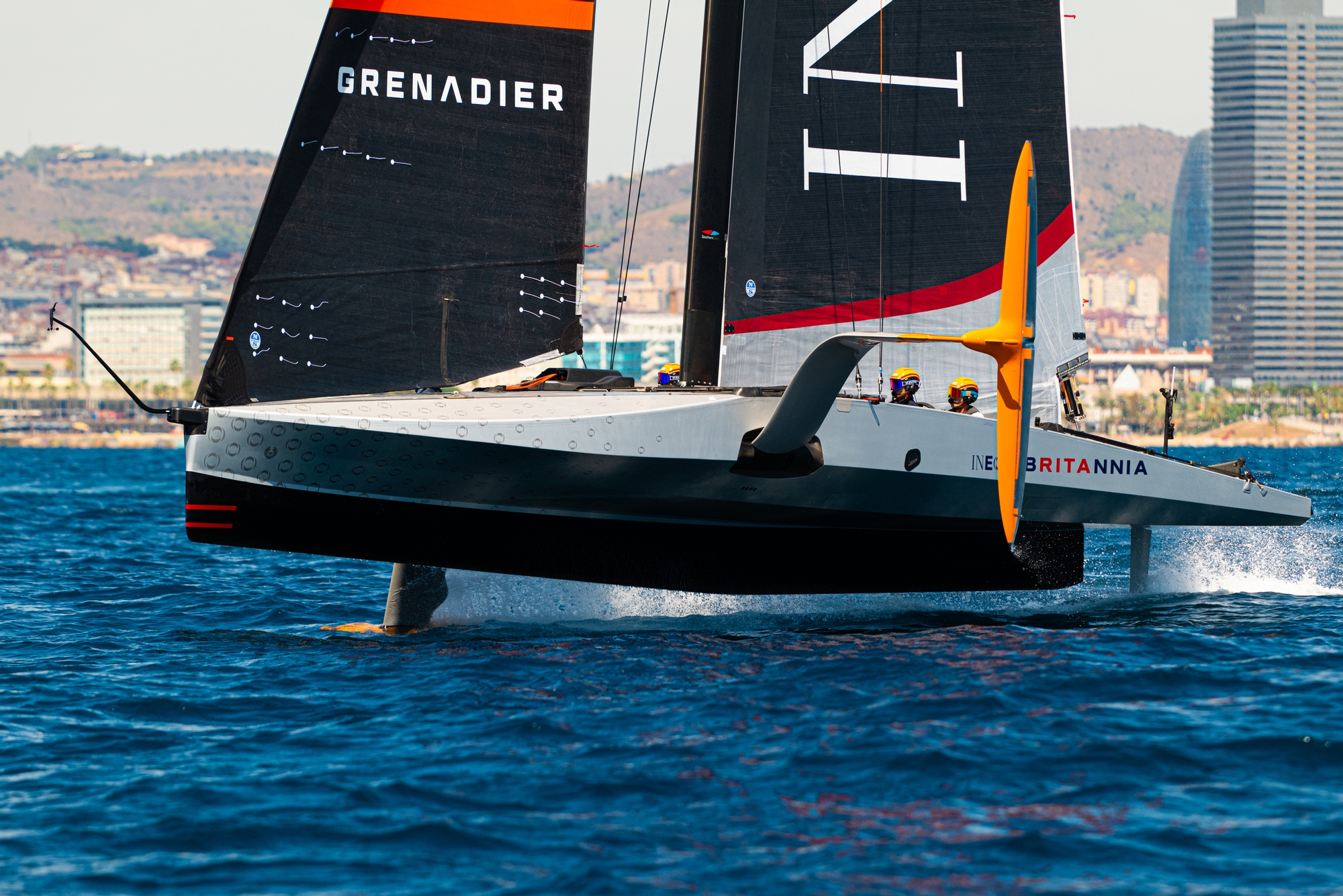
UGO FONOLLÁ / AMERICA’S CUP
